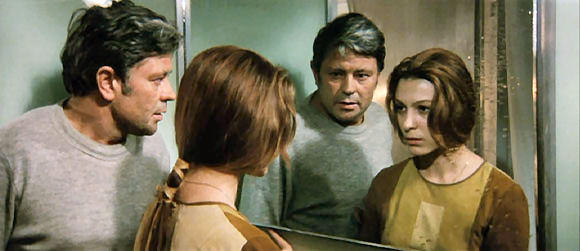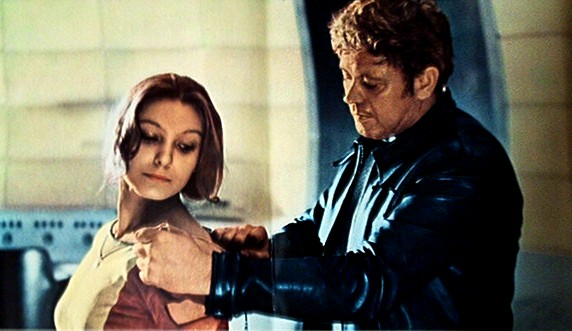In Andrei Tarkovsky’s 1972 film Solaris the first glimpse we catch of the titular planet is in a film of a film of a film. The pudgily somnolent hero, Kris Kelvin (Donatas Banionis), bores us by being stolidly bored himself as he watches the film of the testimony of Henri Burton (Vladislav Dvorzhetsky), a space pilot who way back when saw a giant space baby in the fog above the ocean of Solaris — a giant space baby that was not, we repeat not, cribbed from 2001, damn it, we swear. Young Burton in the film stutters and drones his way through a foggy mire of drab description while an older, balder Burton fusses and twitches, occasionally skipping ahead as if to taunt us with our inability to do the same (or, in the era of DVDs, to goad us into doing so.) Eventually the young Burton in the film cues another film, on which is no baby, but just more foggy mire. Young Burton stutters, old Burton twitches, Kelvin somnolents, and the film ends, and the film ends, and the film trudges wearily on.
Solaris is 2 hours and 45 minutes long. That’s a film that makes you think about film and about the inevitable death duel between film and bladder — or at least it would make you think about that death duel if you were in the theater. As it is, it’s a film that makes you glad you’re watching it on your laptop, flipping off to the wikipedia article on Solaris or to check your email and wandering off to the bathroom and hitting the play button and watching it pick up right where nothing happened before. The first 45 minutes, set on Earth, is in particular, some of the least engrossing cinema I think I have ever witnessed. Kelvin wanders slowly, slowly, slowly around his father’s country homestead, looking at trees, looking at water, and occasionally injecting himself with pounds and pounds of elephant tranquilizer when the camera is momentarily pointed elsewhere. He argues desultorily with his father and sits stoically through an unconvincing sun-shower, soaking himself as if out of spite for the lameness of the effects. Somewhere in there he pokes at a bonfire while telling his father that one of the things that is not in the bonfire is a film of a bonfire. Somewhere else in there we watch Burton (the older, stuttering model) make a videophone call from his car. Then we see him and his son driving in his car. Then we see him and his son driving in his car. Then we see him and his son driving in his car. Then we see him and his son driving in his car. Then we see him and his son driving in his car. Then we see him and his son driving in his car. Then we see him and his son driving in his car. If this is not the longest, most boring scene in all of cinema, it is not for lack of trying.
At this point, you are probably thinking I hate this movie. And I do have some sympathy with the opinion of David Nusair, who in his contrarian review of the film declared:
Ironically though, Kubrick’s 2001 is far less cold and clinical than Solaris – Tarkovsky keeps all his characters at arms-length from the viewer, which prevents us from making any kind of emotional connection to them. The central character, Kelvin, is someone that should elicit sympathy – he did, after all, lose his wife several years ago – but Banionis’ performance is almost infuriatingly reticent (putting it kindly), that it’s virtually impossible to care what happens to him. And since he’s the focus of the film, we’re expected to follow him around for close to three hours (an interminable running time that’s exacerbated by Tarkovsky’s laid-back directorial style).
Like the majority of Ingmar Bergman’s films, Solaris deals heavily with philosophical ideas dealing mostly with the nature of human existence – so much so, it’s surprising that nobody has ever referred to the film as a Bergman flick set in space. But Tarkovsky doesn’t bother with ensuring that such conversations are organic to the story, choosing instead to place them wherever he sees fit. One such sequence, featuring the birthday celebration of a crew member, features the characters going on and on about the meaning of life – but it’s just not interesting. Mostly because we don’t care about these people, but also because the dialogue is so stilted and theatrical, it sounds forced and unnatural.
This is, after all, largely correct. Kelvin is utterly unengaging. The conversations are in general not especially interesting. The dialogue is stilted and theatrical. That’s all true.
But…I actually really enjoyed the movie. It’s not often that a piece of entertainment sets out so thoroughly to alienate. If that scene of Burton and his kid driving through the city was a quarter as long it would be irritating. If it were half as long it would be really irritating. If it were 3/4 as long it would be a good joke. But it goes on even past a joke, until it’s a kind of sublime assault. When you finally, finally cut away and back to Kelvin (doing nothing as usual), it’s almost a physical relief — not unlike emptying your bladder, as it happens. Similarly (speaking of liquids flowing) that cloudburst scene — Kelvin sits on the porch to revel in his last rainstorm before going up into space, but the sensual actuality of earth is a transparent set-up; his last moments on earth are hollowed out — a parody of themselves, which only increases their poignance.
Part of what I liked so much about Solaris is precisely that it is not just a little, accidentally stilted and theatrical. It’s not just slow. It’s sloooooooooooooooooooooooooooooow. Doom metal slow. Tectonic plates scraping together slow. If the tectonic plates were not real tectonic plates, but plastic and pasteboard. It’s like somebody built continent-sized simulacra of continents just so he could watch them not move and revel in their inanimate inauthenticity. It’s beautifully perverse and perversely beautiful; a pratfall so clumsily drawn out that it begins to look like grace. Indeed, the film’s most famous scene is almost precisely that; a zero gravity freefall with Kelvin and his ex-wife’s doppelganger drifting off the floor in an awkward, slow-motion ballet. The scene dares us to suspend our disbelief — to ignore the fact that 30 seconds of freefall would result in an indescribably catastrophic mess, and pretend instead that the brief moment of transcendence exists outside not just gravity, but the laws of gravity. It’s not just the protagonists who are suspended in amber, but reality itself.
As is almost inevitable in a movie of this pace, we’ve gotten a bit ahead of ourselves. To catch back up: Kelvin leaves earth, his mission to decide whether to abort the Solaris project, which has run into mysterious difficulties. When he arrives on the planet, he finds that the station is in disarray — cluttered, uncared for, with two of the scientists uncommunicative and the third, Dr. Gibarian (Sos Sargsyan), dead by suicide. The ocean of Solaris is a giant brain, and it attempts to communicate with the humans by creating solid homunculi from their memories. Kelvin’s personal homunculus/guest appears soon enough in the form of his ex-wife, Hari (Natalya Bondarchuk), who killed herself 10 years before.
The Hari clone at one point, in classic robot/Shylock mode, declares that she has human feelings. And she is somewhat more expressive than Kelvin — but that’s a pretty low bar. When she first appears, she seems mostly confused, wondering aimlessly why she has no shoes, like she’s wandered into the wrong dream without the benefit of being shown a script. Kelvin, blankly as always, tricks her into a rocket and shoots her into space. Soon enough, though, an exact duplicate homunculi shows up, still barefoot and with a buttonless dress. Kelvin has to cut it off her with scissors in a scene that’s intimate, absurd, and more than a little disturbing — it’s like we’re witnessing a primal scene in which we spy on Mom and Dad only to discover that they’re life-sized dolls.
Hari, then, is ersatz — she looks real from a distance, but close up even the clothes are wrong. Dr. Sartorious (Anatoli Solonitsyn) calls her “a mechanical reproduction, a copy.” She’s a stage prop — but then, so is Sartorius himself. Perhaps he is even more so; Hari gets to create an individual character, however hollow. Sartorius though is little more than a moldering trope. He might as well have “cold fish scientist” tattooed on his forehead — he’s as much a creature of decades old horror/sci-fi as the odd dwarfish guest we see for a split second trying to escape from his laboratory. The irascible but kind-hearted Dr. Snaut (Jüri Järvet) is equally familiar — the Dr. McCoy to Sartorius’ Spock and Kelvin’s paunchy Shatner. Only the dead Dr. Gibarian seems to have something like a personality of his own. But, of course, we only see him on film, saying farewell to Kelvin on a recorded message while a young girl guest walks about in the background — a reproduced image in a reproduced image in a reproduced image.
This is a film, then, which, like it’s protagonist, is in love with mechanical reproductions — lies that are real enough to kiss. Indeed, Hari shows herself most human not in her tearful, over-determined declaration of humanity, but rather in the ease with which she embraces artificiality. Some of her most intense moments are love scenes with images. In one sequence, she watches that bonfire film we mentioned earlier, which shows Kelvin, his parents, and, in a quick moment or two, Hari herself (or, rather, not herself.) In another scene, Hari gazes at a Breughel winter scene, as the camera lovingly caresses first the snow covered hill and then Hari’s eyes. In both the film and the Breughel, Hari sees the earth she remembers but has never seen. Her memory, the images and reproductions, are more real than she is.
The Breughel is only one of many heavy-handed, theatrical references to great art. Another involves some leadenly dropped quotes from Cervantes about the beauty of sleep, with its wonderful dreams and its unfortunate link to death. Inevitably with that kind of foreshadowing, the Hari/Kelvin romance ends badly. As Hari becomes more like Hari, she remembers what it was about the mercilessly maudlin Kelvin which led her to off herself. She tries to do the deed by drinking liquid nitrogen, but horrifically regenerates, spasming on the floor like a mannequin hooked up to a generator. Soon thereafter, though, Kelvin gets a fever and becomes delirious. Seizing her chance, Hari slips off and gets the other two scientists to destabilize her — or whatever. The plot plods noiselessly into sci-fi gibberish — Kelvin’s brainwaves have been beamed at the ocean brain, and Solaris, dragged down like everyone by Kelvin’s ennui, has stopped creating guests.
Despite the loss of Hari, Kelvin is (surprise!) unexpressive, musing about whether to return to earth or whether to go down to one of the islands that have mysteriously appeared on the ocean’s surface. As the film ends we see him wandering again around his father’s house — though things are somewhat odd. The water in the pond does not move, and when he looks through the window he sees his father drenched by an indoor deluge — mirroring the unconvincing sun-shower from the beginning of the film. Still, he embraces his father’s knees and the camera pulls back, back, back, revealing that he is not at home but on an island in Solaris. It’s all just a set — a staged fantasy of contact and catharsis created by a brain which, if you squint at it right, seems to look something like God’s, and something like Tarkovsky’s.
The question is, what’s the difference between a fantasy of catharsis and the real thing? Catharsis is an emotion; is the reproduction of an emotion no longer an emotion? If Kelvin falls in love with a homunculus, surely the love is authentic even if the homunculus is not? Solaris is a nested series of false dolls within false dolls — the frozen acting, the heavy tropes, the stumbling unreality of the whole exercise is there to remind you that you’re staring at a sublimely hollow surface. But the mind that made that surface is real. That’s the miracle of art; out of mechanical reproduction, truth.
Maybe. The end of Solaris is beautiful. The unmoving water, the indoor rainfall, the undemonstrative Kelvin clutching his father’s legs — all pack an eerie, undeniable charge. But there’s a feyness there, too, a preciousness; it seems overdetermined, smaller than life. The emotions of a dream may be true, but it’s an insular truth. Tarkovsky is celebrating art, but he is also repudiating it. Kelvin’s love kills herself because she knows he loves, not her, but his own dream of her. At the beginning of the movie when we see the movie of the movie of Solaris all there is is fog. There’s nothing there. Or, at least, nothing that can be caught on film.
___________________
The self-reflexivity of Solaris is talked about less in reviews than I thought it would be. I was sure I couldn’t have been the first one to come up with it, though, and sure enough here’s a whole book devoted to it. It’s by Steve Dillon and is called “The Solaris effect: art & artifice in contemporary American film”. The blurb says, “The book takes its title and inspiration from Andrei Tarkovsky’s 1972 film Solaris, a science fiction ghost story that relentlessly explores the relationship between the powers of nature and art. The author argues that American film has the best chance of aesthetic success when it acknowledges that a film is actually a film. The best American movies tell an endless ghost story, as they perform the agonizing nearness and distance of the cinematic image.”




Kris Kelvin (Donatas Banionis), bores us by being stolidly bored himself as he watches the film of the testimony of Henri Burton (Vladislav Dvorzhetsky), a space pilot who way back when saw a giant space baby in the fog above the ocean of Solaris — a giant space baby that was not, we repeat not, cribbed from 2001, damn it, we swear.
But did that come from Tarkovsky or from Stanis?aw Lem’s novel? I haven’t gotten around to reading my copy of the book as of yet.
I”ll probably comment later on, but if you enjoyed this film, you’ll probably also like his “Stalker” and “Andrei Rublev.”
That’s a good question! I haven’t read Lem’s novel…and probably won’t since I’m not a huge fan of his. The movie departs from it fairly vigorously I understand though, so it could well have been Tarkovsky’s interpolation….any Lem readers know for sure?
And yeah, I plan to try to see Stalker next. It may take me a bit, but it’s on the list….
Mirror/
I think that was added, but the clouds did form into images. Lem’s one of my favorites. Tarkovsky does a good job of fucking the book up.
The book is largely a series of research and theoretical articles discussing the planet. It’s great.
Huh…well maybe I’ll give it a try. I’ve read two books by Lem (The Invincible and…something else….) and neither of them were all that…but maybe third time’s the charm….
Although I love sci fi, I don’t want to see any movie over 2 hours,espeically one that can’t pull you in. I found the cel you show of the final scene interested because the boxer sitting there looks as ersatz as you describe the entire movie. Anyway, at least I can pronounce the name “Dvorzhetsky”
Hey Ann! It is a pretty great movie — though not for everyone. Have you read the book?